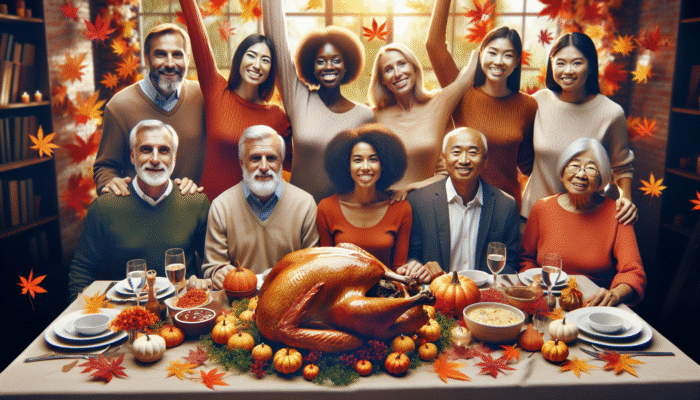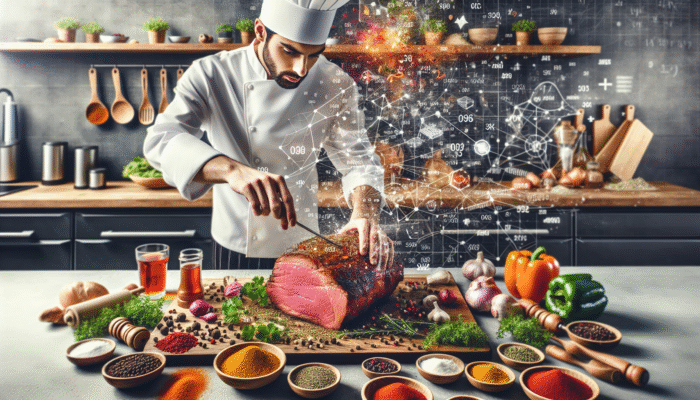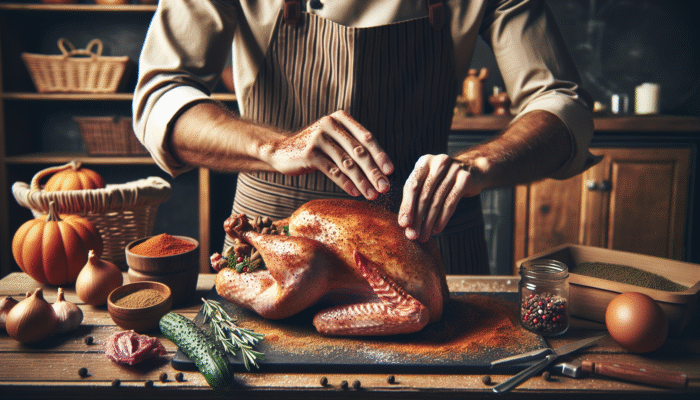Mastering the Art of Turkey Preparation for an Unforgettable Thanksgiving Celebration
Expert Tips for Selecting the Perfect Turkey for Your Holiday Gatherings

Choosing the ideal turkey for Thanksgiving is a pivotal step in your culinary adventure. Begin by assessing the size of your gathering: are you hosting a vibrant family reunion, or is it a more intimate dinner with close friends? For larger celebrations, aim for a turkey weighing between 10-20 pounds, while an 8-12 pound bird is perfect for smaller groups. Many chefs advocate for fresh turkeys due to their superior flavour, yet a meticulously prepared frozen turkey can also produce fantastic outcomes. As you shop, explore various breeds: heritage turkeys are celebrated for their deep, rich flavours, whereas self-basting turkeys offer the convenience of pre-injected seasonings to enhance taste.
Furthermore, it’s essential to consider the source of your turkey. Local markets often feature organic and free-range options that not only taste fresher but also support sustainable farming practices. If you reside in an area where turkeys are less prevalent, investigate international markets that may offer a variety of turkey selections. Online retailers also provide convenient delivery services, ensuring you can secure a quality turkey no matter where you are located. This thoughtful selection process will significantly elevate your turkey-cooking experience, resulting in a delectable centerpiece for your festive table.
Lastly, it is crucial to take into account the dietary preferences and restrictions of your guests. While some may favour white meat, others might have specific allergies or dietary intolerances. By offering a variety of turkey options or preparing accompanying side dishes that cater to these needs, you foster an inclusive dining environment that everyone can appreciate. This careful attention to detail guarantees that your Thanksgiving feast will be memorable for all the right reasons, leaving your guests satisfied and delighted.
Essential Safe Thawing Methods for Preparing Your Turkey
Implementing safe thawing methods is critical when preparing your turkey, as it directly influences both the flavour and food safety. The refrigerator method is the most reliable technique, allowing the turkey to thaw evenly while ensuring it stays at a safe temperature. As a general guideline, allocate 24 hours of thawing time for every 2.5 kg (approximately 5 pounds) of turkey. For instance, if you possess a 4 kg turkey, plan for at least 2 days in the refrigerator, making it vital to organise your cooking schedule in advance.
Avoid thawing your turkey at room temperature, as this can encourage bacterial growth. If time is of the essence, consider utilising the cold water thawing method, which requires submerging the turkey in its packaging in cold water, changing the water every 30 minutes. This method typically necessitates about 30 minutes of thawing time for each pound of turkey, providing a quicker yet safe option for those pressed for time.
Once your turkey is thoroughly thawed, it is essential to prepare it promptly to maintain its quality. Ensure the turkey remains at a safe temperature and avoid leaving it unrefrigerated for extended periods. This care is crucial not only for achieving that perfectly cooked Thanksgiving turkey but also for safeguarding the health and safety of your guests.
Enhancing Flavour and Moisture through Brining Techniques
Brining can transform your turkey into a flavourful, succulent masterpiece that will impress your guests. This technique involves soaking the bird in a saltwater solution, enhancing both its flavour and moisture retention significantly. A basic brine can be created by dissolving 1 cup of salt and, for added sweetness, ½ cup of sugar in 4 litres (approximately 1 gallon) of water. Feel free to personalise your brine by incorporating flavourings such as garlic, rosemary, thyme, or even citrus zest, tailoring it to your taste preferences and making your turkey distinctly memorable.
To commence the brining process, ensure the turkey is fully submerged in the brine and refrigerate it for a minimum of 12 hours, but no more than 24 hours, to achieve optimal results. The science behind brining is based on osmosis: as the turkey absorbs the brine, the muscle fibres relax, allowing moisture to be locked in during cooking. The final outcome? A juicy, flavour-packed turkey that will undoubtedly impress your guests. Feel free to experiment with various brine recipes to discover your signature flavour that will elevate your Thanksgiving meal.
Maximising Flavour: Expert Seasoning and Stuffing Techniques for Your Turkey

Crafting a Delicious Turkey Rub to Elevate Your Roast
Creating a flavourful rub for your turkey is an excellent opportunity to customise its taste profile. A thoughtfully crafted turkey rub can elevate your dish from ordinary to extraordinary, serving as a simple yet effective way to incorporate your favourite spices. Begin with a base of salt and pepper, then add classic herbs such as thyme, rosemary, and sage to capture that quintessential Thanksgiving flavour.
Don’t hesitate to include garlic powder, onion powder, or a hint of cayenne for an extra flavour kick. Mixing in oils, like olive or canola oil, can help the rub adhere to the turkey while promoting a beautifully browned exterior during cooking. Use your hands to thoroughly massage the rub all over the turkey, ensuring it reaches under the skin where it can infuse the meat with rich flavours more effectively, resulting in a mouth-watering outcome.
For those feeling adventurous in the kitchen, consider experimenting with international flavours. A Jamaican jerk seasoning, a za'atar blend from the Middle East, or a tandoori mix from India can add an exciting twist to traditional recipes. This diversity not only broadens your culinary repertoire but also enriches your journey in mastering how to cook a Thanksgiving turkey perfectly.
Stuffing Techniques to Amplify the Flavour of Your Turkey
The tradition of stuffing a turkey is a cherished practice, but it demands meticulous attention to detail, particularly regarding food safety. Whether you opt for a classic bread stuffing or explore alternatives like quinoa or rice, ensure that your stuffing reaches a safe internal temperature of 74°C (165°F) to avert any risk of foodborne illness.
For a delicious traditional stuffing, utilise stale bread cubes, sautéed vegetables such as onions and celery, and a blend of herbs for a comforting flavour. Moisten the mixture with broth and season thoroughly before packing it into the turkey's cavity. Alternatively, consider modern twists, such as adding dried fruits like cranberries or apricots for a hint of sweetness, or nuts for extra texture and flavour.
While stuffing contributes moisture and depth of flavour, you might choose to cook the stuffing separately if you are concerned about achieving the correct cooking times or temperatures. This method allows you to achieve a crispy texture while ensuring the turkey remains moist and tender. Regardless of your chosen method, ensuring even heat distribution in the stuffing is vital for mastering how to cook a Thanksgiving turkey perfectly.
Strategic Application of Seasoning for Maximum Impact

The process of applying seasoning is a vital step in how to cook a Thanksgiving turkey perfectly. For optimal results, begin with a dry turkey by patting it down with paper towels to remove any excess moisture. This technique allows the seasoning to adhere more effectively while promoting a crispy skin that will be the envy of your guests and a delight to your palate.
Generously apply the seasoning both under the skin and on the surface, ensuring every nook and cranny is well-flavoured. This method not only enhances the overall taste but ensures that the seasonings penetrate the meat, resulting in a turkey bursting with flavour in every bite, captivating your guests’ taste buds.
To achieve an even distribution of seasoning, consider employing a combination of sprinkling and a gentle massage technique. This approach ensures that the flavours meld beautifully during the cooking process. Don't hesitate to explore various seasoning techniques, such as incorporating citrus zest or an herb-infused oil rub, to discover the perfect balance that complements your palate and enhances your Thanksgiving experience.
Exploring Cooking Methods for Achieving the Perfect Turkey
Roasting Your Turkey for Flawless Golden-Brown Results
Roasting is arguably the most traditional method for preparing a turkey, offering a straightforward approach to achieving that desirable golden-brown exterior and juicy meat. Begin by preheating your oven to a temperature ranging from 170°C to 180°C (340°F to 350°F). This temperature range allows for even cooking without drying out the turkey, creating a beautifully moist bird that will please every palate at your table.
Regularly basting the turkey throughout the roasting process is crucial for moisture retention. Use the pan juices to baste, which not only adds flavour but also helps to develop that stunning crispy skin you desire. For added depth of flavour, consider incorporating butter or a flavoured fat into the basting mixture, enriching the overall richness of your dish and enhancing the turkey’s appeal.
Cooking times will vary depending on the weight of the turkey, with a general guideline of approximately 13-15 minutes per pound. However, the most reliable method remains using a meat thermometer; aim for an internal temperature of 74°C (165°F) in the thickest part of the thigh. This ensures that your turkey is safe to eat and perfectly cooked, contributing to a successful meal that enhances your culinary reputation among friends and family.
Maximising Convenience with a Turkey Roaster
If you’re looking to simplify your cooking process, a turkey roaster can be a transformative tool in your kitchen. These appliances provide even cooking, allowing you to free up valuable oven space for side dishes and desserts, making your Thanksgiving preparation more efficient. Be sure to adhere to the manufacturer’s guidelines for temperature settings, as some models may require specific adjustments for optimal performance.
Utilising a turkey roaster can also streamline cleanup due to the built-in drip trays. This efficient method is especially advantageous for large gatherings, where managing space and timing is critical for a successful dinner, allowing you to focus on enjoying the occasion rather than stressing over logistics.
To achieve optimal flavour, consider adding aromatic vegetables and herbs to the roaster, which will infuse the turkey with delightful aromas as it cooks. This method not only yields a delicious bird but also creates a fragrant base for gravies and sauces, ensuring your Thanksgiving meal is unforgettable and truly special.
Deep Frying for an Unconventional Crispy Texture
Deep frying may seem unconventional, but it offers a unique and delicious method for cooking your turkey. This process involves immersing the entire bird in hot oil, resulting in a crispy skin and juicy meat that many find irresistible. However, safety must always be your top priority: ensure you use a turkey fryer outdoors to minimise any potential hazards and maintain a safe cooking environment.
The ideal oil temperature for deep frying is around 175°C (350°F), with a general rule of thumb being to fry the turkey for approximately 3-4 minutes per pound. Ensure that the turkey is completely thawed and dry before immersing it to avoid dangerous oil splatters that could result in burns or accidents during the cooking process.
When executed correctly, deep frying can yield a beautifully crispy texture that many find irresistible. Pair this cooking method with a homemade marinade or rub to deepen the flavour profile, creating an exciting culinary experience. This technique can serve as a fabulous conversation starter and a highlight of your holiday celebrations, showcasing your culinary prowess and creativity in the kitchen.
Smoking Your Turkey for Rich, Complex Flavours
Smoking is an exceptional way to impart rich, complex flavours to your turkey. This low-and-slow method requires patience but rewards you with a unique taste profile that is hard to surpass. Maintaining a consistent temperature of about 107°C to 135°C (225°F to 275°F) throughout the smoking process is key to achieving the best results and ensuring that your turkey is infused with aromatic goodness.
Choose your wood chips wisely; hickory, apple, and cherry woods are popular choices that impart distinct flavours to the meat, enhancing the overall experience. Soaking the chips in water prior to use can enhance smoke production, creating an aromatic experience that will tantalise your guests' senses and elevate your holiday meal.
Timing is crucial in smoking, with a general guideline of approximately 30 minutes of smoking per pound of turkey. Using a meat thermometer is essential to ensure that the internal temperature reaches a safe 74°C (165°F). The outcome is a tender, flavourful turkey that is sure to impress even the most discerning palate at your Thanksgiving table, making it a meal to remember.
Spatchcocking for Efficient and Even Cooking
Spatchcocking, also known as butterflying, is a technique that allows for even cooking and reduced cooking time by flattening the turkey. This method involves removing the backbone, enabling the bird to sit flat, which promotes even heat distribution throughout the cooking process, ensuring that every bite is perfectly cooked and incredibly juicy.
This technique can significantly decrease cooking time while ensuring that the turkey remains succulent. Generously season the turkey before roasting, allowing flavours to penetrate more deeply into the meat. This practical tip is invaluable for those eager to learn how to cook a Thanksgiving turkey perfectly, as it opens new avenues for experimentation with seasoning and flavour profiles that can enhance your dish.
Moreover, spatchcocking allows for an impressive presentation, with the flattened bird creating a stunning canvas for garnishing and serving. Pair this technique with your preferred cooking method for a memorable dining experience that will surely leave a lasting impression on your guests, ensuring that your Thanksgiving celebration is as delightful as it is delicious.
Mastering Temperature and Timing for Culinary Excellence
Utilising a Meat Thermometer for Accurate Cooking
A meat thermometer is an indispensable tool for ensuring your turkey is cooked to perfection. The ideal internal temperature for a turkey is 74°C (165°F) in the thickest part of the thigh. This precise measurement guarantees that the meat is safe to consume while retaining its moisture and tenderness that everyone craves during a festive meal.
Insert the thermometer before the turkey is fully cooked to avoid overcooking. If you find that the thighs reach the desired temperature first, consider tenting the breast with foil to prevent it from drying out. This careful attention to temperature plays a critical role in your success in how to cook a Thanksgiving turkey perfectly, ensuring a meal that delights and satisfies your guests.
For those seeking added precision, consider using a digital thermometer equipped with an alarm feature, which can alert you when the turkey reaches the set temperature. This is particularly useful during holiday gatherings, allowing you to focus on other preparations without the constant need to monitor the oven closely, ensuring a stress-free cooking experience.
Estimating Cooking Time for Effective Meal Planning
Calculating cooking time is essential in planning your Thanksgiving meal effectively. The general guideline is to allow approximately 13-15 minutes per pound for an unstuffed turkey and 15-18 minutes for a stuffed one. These guidelines will assist you in scheduling your cooking, ensuring that everything is prepared and ready when your guests arrive, preventing any last-minute stress or chaos in the kitchen.
However, it’s important to note that cooking times may vary based on several factors, including oven calibration and the turkey's size and shape. Using a meat thermometer remains your most reliable method for accuracy. Additionally, always allow for some extra time in your planning to accommodate any unexpected delays or adjustments during the cooking process, ensuring a smooth and enjoyable Thanksgiving dinner.
Keep in mind that resting time is also a vital factor; your turkey needs at least 20-30 minutes to rest before carving. This crucial step allows the juices to redistribute, ensuring a moist and flavourful turkey that will delight your guests and leave them wanting more, making your Thanksgiving feast a resounding success.
Understanding the Importance of Resting Your Turkey
Resting your turkey is a critical step that is often overlooked yet essential for achieving the best possible outcome. After cooking, allow the turkey to rest for a minimum of 20-30 minutes. This resting period enables the juices to redistribute throughout the meat, ensuring that every slice is juicy and tender, creating a truly exceptional dining experience that your guests will cherish and remember.
Cover the turkey loosely with foil during the resting period to keep it warm. While it rests, take the opportunity to prepare your side dishes or finish any sauces or gravies; this timing coordination is key to executing a seamless Thanksgiving dinner that impresses everyone and enhances the overall experience.
The resting time also serves as an excellent moment for everyone to gather around the table and appreciate the feast ahead. The anticipation builds as the enticing aroma fills the air, creating a memorable prelude to your meal that sets the tone for a delightful gathering filled with joy and laughter.
Carving and Serving: The Grand Finale of Your Thanksgiving Feast
Mastering the Art of Carving Your Turkey with Precision and Care
Carving a turkey can be an art form, and with the right technique, you can achieve beautifully sliced pieces that will impress your guests. Start with a sharp carving knife to make clean, precise cuts. Begin by removing the legs and thighs, slicing through the joint where they connect to the body for a clean separation, ensuring that each piece is visually appealing.
Next, carve the breast meat by slicing it off the bone in long, even strokes. This method not only produces attractive slices but also keeps the turkey looking pristine on the serving platter, enhancing its visual appeal and making a statement at your Thanksgiving table. A carving fork can provide stability, making the carving process smoother and safer for you, allowing you to focus on presentation.
Consider presenting the turkey on a large platter, arranging the slices neatly and garnishing with fresh herbs or citrus slices to enhance the visual appeal. This thoughtful presentation can elevate the overall dining experience, leaving a lasting impression on your guests and showcasing the effort you put into preparing the meal, making it feel truly special.
Creating an Attractive Platter Arrangement for Your Turkey
Presentation is paramount in your Thanksgiving feast, so take the time to arrange your carved turkey attractively on a platter. Start by placing the larger pieces, such as the legs and wings, before layering the breast slices neatly over them for an organised and visually pleasing look.
Add colourful garnishes such as fresh herbs, cranberries, or slices of citrus, which will not only add visual interest but also complement the rich flavours of the turkey. Consider incorporating seasonal elements like ornamental pumpkins or autumn leaves for a festive touch, ensuring that the presentation is as memorable as the meal itself, captivating your guests from the moment they sit down to dine.
Investing time in the final presentation of your turkey signifies the effort put into the entire cooking process. Your guests will surely appreciate the attention to detail, enhancing their overall dining experience and creating cherished memories that will last long after the meal is over, adding to the joy of the Thanksgiving celebration.
Thoughtful Serving Suggestions for a Memorable Thanksgiving Meal
Traditional Thanksgiving sides, such as creamy mashed potatoes, savoury stuffing, and tangy cranberry sauce, pair beautifully with turkey, creating a harmonious meal. However, don’t hesitate to experiment with new and exciting accompaniments that reflect your culinary creativity. Consider roasted root vegetables seasoned with Moroccan spices or a fresh salad featuring seasonal fruits and nuts for a delightful twist that surprises your guests and enhances the dining experience.
Including a selection of sauces, such as rich gravy or zesty chimichurri, can elevate the entire meal and enable your guests to customise their plates to suit their tastes. Be mindful of diverse dietary preferences; offering vegetarian or gluten-free options ensures that everyone can partake in the feast without restrictions or concerns, fostering a warm and inclusive atmosphere.
Ultimately, the goal is to create a balanced and vibrant spread that showcases the turkey as the star of the show while complementing it with a variety of delicious sides that will delight your guests, ensuring a memorable Thanksgiving celebration filled with joy, laughter, and gratitude.
Smart Strategies for Storing Leftover Turkey Safely and Deliciously
Properly storing leftover turkey is essential for enjoying this delicious dish in the days following your feast. Aim to refrigerate leftover turkey within two hours of serving to prevent any risk of bacterial growth and ensure food safety. Store the turkey in airtight containers, and be mindful to separate dark and white meats if they will be used differently in future meals, helping to maintain their distinct flavours.
Leftover turkey can last for up to four days in the fridge, allowing you to savour the flavours of Thanksgiving long after the holiday has passed. For longer storage, consider freezing the meat in portioned containers or vacuum-sealed bags. This approach allows you to enjoy your delicious turkey well beyond the Thanksgiving holiday, providing a taste of your festive celebration for weeks to come, preserving the joy of the season.
Get creative with your leftovers; they can lead to exciting new culinary adventures, from scrumptious sandwiches to hearty casseroles. Don’t let any of those delicious remnants go to waste; find inventive ways to repurpose your turkey into delightful new dishes that everyone will love, ensuring that your Thanksgiving spirit continues even after the last bite has been savoured.
Maximising Your Turkey Experience: Leftovers and Storage Strategies
Efficiently Storing Leftover Turkey for Future Enjoyment
Storing leftover turkey correctly is pivotal in maintaining the quality and safety of your meal. Begin by refrigerating any turkey leftovers within two hours of cooking to avoid any risk of foodborne illness and ensure freshness. Use airtight containers to keep out moisture and odours while ensuring the turkey remains suitable for future enjoyment, extending the life of your delicious dish.
Organising the turkey by separating dark and white meat is advisable, as these can be utilised in different recipes later. Cooked turkey can last for up to four days in the refrigerator, but if you plan to keep it longer, consider freezing it to preserve its taste and texture for future meals, ensuring that nothing goes to waste.
When freezing, slice the turkey into portions for easier defrosting later on. Vacuum sealing is an excellent technique for maintaining freshness and preventing freezer burn, allowing you to savour your turkey weeks after the holiday. By employing proper storage techniques, you can significantly enhance your culinary experience and make the most of your Thanksgiving meal, ensuring every bite is as delightful as the first.
Reheating Leftovers Safely and Deliciously
Reheating leftovers must be done with care to maintain quality and ensure safety. The ideal method for reheating turkey is in the oven, which helps retain moisture and ensures even heating. Preheat your oven to 175°C (350°F) and place the turkey in a baking dish, covering it with foil to lock in moisture for a tender result that mirrors the original meal experience.
For smaller portions, the microwave can be a convenient option; however, be cautious of uneven heating. Always stir or rearrange the meat to avoid cold spots that may harbour bacteria, ensuring every bite is safe and enjoyable. Aim for an internal temperature of 74°C (165°F) before serving to ensure your turkey is safe to eat and delicious, offering the same satisfaction as the initial feast.
Additionally, consider reheating any sides alongside the turkey for a complete meal remake. This strategy allows for a quick and easy dinner while ensuring that the flavours remain consistent with your original Thanksgiving feast, creating a satisfying experience for everyone and minimising food waste.
Creative Ways to Transform Leftover Turkey into Exciting New Dishes
Making the most of your leftover turkey opens the door to culinary creativity and innovation. Transform the remaining meat into savoury turkey sandwiches, loaded with cranberry sauce and stuffing for a delightful post-Thanksgiving treat that captures the essence of the holiday. Alternatively, consider crafting a hearty turkey soup or a comforting casserole that utilises every last bit of meat, providing nourishment and satisfaction for your post-holiday meals.
Experimenting with different flavours can lead to exciting new dishes. For example, try mixing turkey with Asian-inspired ingredients like hoisin sauce and ginger for a unique stir-fry, or incorporate it into tacos with fresh toppings for a fun twist on your leftovers that will surprise and delight your family and friends.
The possibilities are endless when it comes to repurposing turkey, allowing you to savour the flavours of Thanksgiving long after the holiday has passed. With a bit of imagination and creativity, your leftovers can become just as exciting and enjoyable as the main event, ensuring the spirit of Thanksgiving lingers well into the future.
Frequently Asked Questions About Turkey Preparation for Thanksgiving
How long does it take to cook a turkey for Thanksgiving?
Cooking time for a turkey typically ranges from 13 to 15 minutes per pound for an unstuffed bird and 15 to 18 minutes per pound for a stuffed one. Always utilise a meat thermometer to check for doneness, ensuring safety and quality for your holiday meal.
What is the best way to thaw a frozen turkey safely?
The safest method to thaw a frozen turkey is in the refrigerator, allowing 24 hours for every 2.5 kg (5 pounds) of turkey. For a quicker option, you can submerge it in cold water, changing the water every 30 minutes to maintain safety and prevent bacterial growth.
Can I stuff the turkey the night before cooking?
It's not recommended to stuff the turkey ahead of time due to potential food safety risks. Instead, prepare the stuffing just before you are ready to cook to ensure optimal safety and quality, allowing for a delicious result that everyone will enjoy.
What should I do if my turkey is not cooking evenly?
If your turkey isn't cooking evenly, you can tent areas with foil that are browning too quickly to prevent burning. Always use a meat thermometer to ensure all parts reach the safe cooking temperature of 74°C (165°F) for optimal safety and quality, ensuring a successful Thanksgiving meal.
How do I keep the turkey moist while cooking?
Basting the turkey every 30-45 minutes with pan juices or melted butter can help keep it moist throughout the cooking process. Additionally, consider brining the turkey beforehand to enhance moisture retention and flavour, ensuring a succulent and delicious result that will impress your guests.
Can I cook a turkey from frozen safely?
Yes, you can cook a frozen turkey, but it will take approximately 50% longer than a thawed bird. Always check the internal temperature with a meat thermometer to ensure it reaches the safe cooking temperature of 74°C (165°F) before serving.
What are some creative leftover turkey recipes I can try?
Leftover turkey can be transformed into delicious sandwiches, soups, casseroles, or even tacos. Feel free to get creative and experiment with different flavours to enjoy your leftovers in exciting new ways that keep mealtime interesting and enjoyable for everyone.
How should I store leftover turkey properly?
Store leftover turkey in airtight containers within two hours of serving. It can last up to four days in the refrigerator or be frozen for longer storage, allowing you to enjoy your turkey beyond the holiday and reduce waste, ensuring that nothing goes to waste.
What temperature should the turkey be when it is done cooking?
The turkey should reach an internal temperature of 74°C (165°F) in the thickest part of the thigh to ensure it is safe to eat and cooked to perfection, providing peace of mind for your Thanksgiving celebration.
Can I use the turkey carcass for soup after the meal?
Absolutely! The turkey carcass can be simmered to create a rich and flavourful broth, perfect for soups or stews. Simply add vegetables and seasonings to enhance the flavour and nutritional value of your dish, making the most of every part of the turkey and minimising waste.
Connect with us on Facebook for more culinary tips!
The post How to Cook a Thanksgiving Turkey Perfectly: A Universal Guide appeared first on Cooking Gods.
The Article Thanksgiving Turkey Cooking Tips for Perfect Results Was Found On https://limitsofstrategy.com

